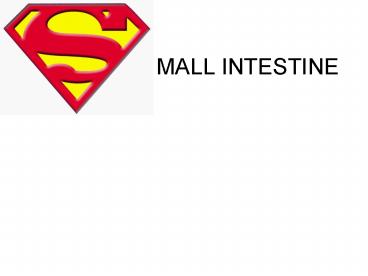MALL INTESTINE - PowerPoint PPT Presentation
1 / 10
Title:
MALL INTESTINE
Description:
In humans over 5 years old it is approximately 7 m (21 ft) long and can vary ... Cholic acid. Chenodeoxycholic acid. Glycocholic acid. Taurocholic acid ... – PowerPoint PPT presentation
Number of Views:31
Avg rating:3.0/5.0
Title: MALL INTESTINE
1
MALL INTESTINE
2
(No Transcript)
3
Overview
- In humans over 5 years old it is approximately 7
m (21 ft) long and can vary from 4-7 m
(13.12-22.97 ft). - It is divided into three structural parts
- Duodenum 26 cm (9.84 in) in length
- Jejunum 2.5 m (8.2 ft)
- Ileum 3.5 m (11.5 ft)
- Although the small intestine is much longer than
the large intestine (typically 4-5 times longer),
it is referred to as such due to its
comparatively smaller diameter. On average, the
diameter of the small intestine of an adult human
measures approximately 2.5-3cm, and the large
intestine measures about 7.6 cm in diameter - The small intestine is the portal for absorption
of virtually all nutrients into blood
4
Structure small intestine
The villi are hair-like protrusions INTO the
intestine -- emanating from the wall of the
intestine. The purpose of the villi is to slow
the passage of food, and to allow food particles
to be captured in among these finger-like villi
-- so that the blood inside the villi can absorb
the nutrients in the food.
5
Chemical digestion
- After food is churned up in your stomach, a
sphincter muscle at the end of your stomach opens
to squirt small amounts of food into the top of
your small intestine. This first section of the
small intestine is called the duodenum. - Your pancreas releases digestive juices through a
duct into your duodenum. This fluid is rich in
enzymes that break down fats, proteins and
carbohydrates. It also contains sodium
bicarbonate which neutralises acid produced in
your stomach. - Your gall bladder squeezes out bile down a duct
into your duodenum. Bile helps break down fats in
your food.
6
Peristalsis
- Digesting food is pushed through the small
intestine by peristalsis. Peristalsis is a
muscular movement in which alternating waves of
muscle contraction and relaxation cause food to
be squeezed along the digestive tract.
7
Absorbing nutrients
- Most of the nutrients in the food you eat pass
through the lining of your small intestine into
your blood. The lining of the small intestine is
covered in tiny microvilli. These are
microscopic, finger-like protrusions which give
the lining of the small intestine a massive
surface area for absorption of nutrients to occur
across. The microvilli give the inside of the
intestine the look and feel of velvet. - Each microvillus contains a minute blood
capillary. When nutrients are absorbed into a
microvillus, they enter its blood capillary. This
is how nutrients from your food enter your blood.
8
Indigestible food passes into the large intestine
- By the time food leaves your small intestine all
the nutrients in your food will have entered your
bloodstream. All that remains is indigestible
food which is passed from your small intestine to
your large intestine for further processing.
9
Bile
- Bile salts are steroids with detergent properties
which are used to emulsify lipids in foodstuff
passing through the intestine to enable fat
digestion and absorption through the intestinal
wall. - The five principle bile acids are
- Deoxycholic acid
- Cholic acid
- Chenodeoxycholic acid
- Glycocholic acid
- Taurocholic acid
10
- Villi are structures, which act as valves, which
allow solids liquids and/or acids to pass through
one structure to another - Most of food absorption is processed by the small
intestine. The small intestine has three
structures to handle absorption, villi,
microvilli and the circular folds. The purpose of
villi, microvilli and the circular folds is to
increase the area of absorption within the small
intestine. Microvilli are small projections of
the mucous membrane of the small intestine walls.
The microvilli give the small intestine walls a
fuzzy appearance and are also know as the brush
border. The structure of Villi is very similar to
the microvilli except that villi are
substantially larger than microvilli. Within all
villi are a large number of capillaries and a
lymphatic capillary as well.































